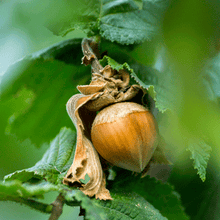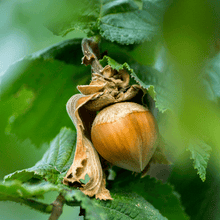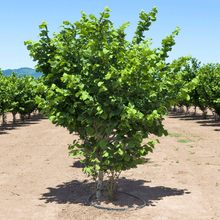Bountiful, Native Hazelnut Plant
Receive a Bountiful Crop of Native Nuts
Growing wild across eastern U.S. woodlands and prairies, the American Hazelnut is a prolific and easy-to-tame shrub, well suited for garden living!
Make room in your pantry! The American Hazelnut starts to bear fruit within 1 to 3 years of planting. Another 5 years and it’s producing up to 25 pounds of sweet, nutty morsels!
Tall with Fall Beauty
Often disguised as a small tree, this native species gets about 18 feet high with long outward-extending stems.
Ample leaves are round and jagged with fine, fuzzy hairs covering both sides. A lush shade of green through the growing season, its foliage is bright and theatrical in fall, ranging in shades of rusty-violet to golden-yellow.
“Bite-Sized” Super Food with Year-Round Benefits
Although this inconspicuous nut has many medicinal benefits, its acclaim is its rich, earthy flavor and versatility in the kitchen. Whether roasted, ground into flour, turned into butter or eaten right from the shell, the hazelnut is a healthy inclusion to countless main-course dishes, sweet-treats, cereals and drinks.
It’s a valuable source of protein, fiber, vitamins and minerals and can be enjoyed raw or lightly toasted for additional crunch. Best of all, the meaty kernel is extracted with a simple crack!
Unshelled hazelnuts can be stored for a year or better. Cracked nuts should be used within a few weeks or kept in the freezer to extend freshness.
Favorite Wildlife Fare
If your harvest is intended for the local wildlife community, rest assured the American Hazelnut is a menu favorite. Squirrel, deer, turkey and other woodland creatures are guaranteed a feast with these nutrient-rich nuts. Resident birds find the male flower a reliable winter provision, while other animals will forage on tender branches and foliage for added sustenance.
Easiest Nut to Grow!
This is a durable, wild plant. Growing the hazelnut bush requires little-to-no-effort. Its American “roots” have adapted to a wide range of climates – USDA zones 4 through 9 -- and are generally undeterred by harmful pests.
While you’ll want to give yourself some room for produce collection, its shrub-like size fits in most outdoor spaces. The light branches can be pruned to your needs, while its broad-leafed foliage proves useful as privacy screen or windbreak.
With an American Hazelnut Filbert from Fast Growing Trees, you’re just a few years from realizing your own harvest of sweet, tender nuts! Don’t let the season slip by. Get your order in today!
Planting & Care
Seasonal, Location, and Exposure Considerations:
The American Hazelnut ‘Filbert’, though called a tree, grows more as a shrub whose size is easily manageable with pruning. You will need to plant near pollinator varieties of similar flowering habit; or better yet, as a group with spacing about 15’ apart to give them plenty of room. Their ideal location will be in a partial to fully shaded site; or a dappled sun aspect. Keep direct sunlight to less than four hours a day, morning or evening light is best in warmer regions. For spacing, remember these shrubs will grow to about 18’ tall. Use the lower range of these in cooler climates. They are generally rated to grow in USDA Zones 5-9 ideally, but can potentially grow as cold as Zone 4. It takes 1-3 years before Filberts will begin to bear. Their production peaks about 3-4 years later, then becomes rather erratic after 10 years or so, unless they are aggressively managed with pruning.
Nuts from this variety can be harvested on the ground after they mature and drop from the tree. Husks of the nut must be removed, then dry out the nuts by spreading in a warm, dry, and shady location.
Soil Preferences
The American Hazelnut Filbert adapts well to a range of soil pH’s, best to aim for slightly acidic to near pH 7, but avoid alkaline soils above that, or adjust with sulfur, and maintain acidity with amendments containing sulfate. Your soil and media should not be excessively fertile if you are going after flowers and nuts. Too rich a soil results in plentiful foliage and reduced flowering.
A slightly acidic, loamy soil is best. If they had their choice, they would be living on the edge of forests…keep that in mind.
Planting and Care – Container Grown or in Pots
The American Hazelnut Filbert, due to its rooting and growth habit, is not suitable for growing in containers.
Planting and Care – Outdoor Growing in the Garden
The best time of year to plant your Filbert is in late winter, or very early spring as soon as any frost is out of the ground, and the soil is dry enough to work. Make your hole twice the width of the container it came in, but no deeper. Break up the walls of your hole with a rake or forked hoe, to loosen the media in which your shrub will want to grow. Fill the hole with water and let it drain, watering the soil around the hole copiously to create a nice damp condition.
If the root ball has natural burlap around it, remove the wires or rope, and pull the burlap away from the root ball, to have it lay like a blanket under the bush in the bottom of the hole. If the burlap or other covering is synthetic, remove it entirely. If root bound, use sharp hand pruners to remove any stray circling roots from the mass by cutting them at the top of the root mass.
The shrub must sit at the same depth in your garden as it is in the pot. Adjust accordingly. Backfill using the soil extracted and firm gently by hand as you add soil to the hole. Form a ‘dam’ around the hole you dug with remaining soil, usually 2-4” is enough, and then water thoroughly. This creates something of a ‘container’ for the water to keep the soil moist after watering.
Mulching is advised, but keep it about 5” from the base of the shrub. 2-3” of mulch is recommended. Any root suckers that might be present should be cut just below the ground and removed to discourage the shrub from growing as a thicket form.
Watering
Plan to water often after planting, likely for the first year. Once or twice a week should be expected, paying special attention during periods of drought. Once the shrub is established in its second year, you can plan to water every week or two when it isn’t raining normally, and more often in dry spells.
Fertilizing
Excessive fertility should actually be avoided with Filberts. Especially if you’re looking for good flower and nut production. When in too fertile a soil environment, they will push more vegetation and suckers, and less energy to flowering.
Weed, Insects, and Diseases
Mulch will suppress weeds very well. If your planting site has a sod, remove the sod layer completely and replace the soil with a similar texture and fertility level. The most common disease is ‘eastern filbert blight’. Consult your local Cooperative Extension or Nursery for tips on identification and control.
Leaf roller moths can be a challenge when they are in the larval stage. Look for web like structures which cause a leaf rolling effect. Insecticides are generally ineffective as the insect is protected by the leaf tissue rolled around it. Cut off effected branches and dispose of far away from the site and/or by burning
Pruning and Training
Cleanliness and the use of sharp trimmers is important. This keeps pathogens from finding a home in the bark of your Hazelnut tree. Make clean cuts next to the collar of the branch to prevent disease pathogen introduction further. Moderate pruning is advised on mature Filberts. Flowers and nuts are produced on the shoots that are between 5-10” long. Pruning encourages nut production as well. When pruning, do so in the winter. Aim for an open orientation of the branches and shoots for improved air circulation. When removing old growth, cut clear to the ground. When they are mature, remove about a third of the oldest branches at a time, thin out overcrowded areas of the shrub, and cut back crossing branches as they will inhibit that open growth you’re after.
Suckers sprouting from the roots should be dug out completely. They tap energy from the main plant, and create too much thicket around the shrub.
*Note: Nut production is maximized in growing zones 6 and above. If you live in a hotter zone, you may see smaller nut harvests.





